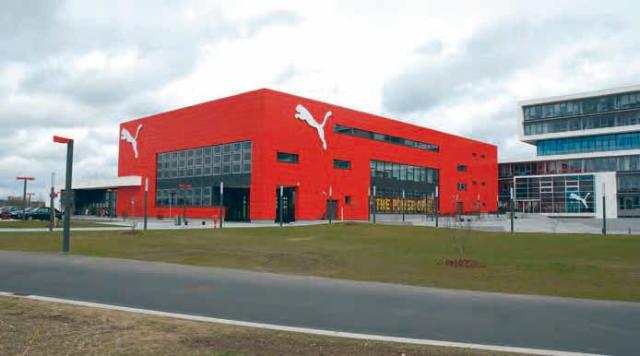PUMA's green ambitions demanded chemical-free lime protection
When PUMA planned the construction of a new headquarters under the name "PUMAVision Headquarters", the ambition was to be the first completely climate-neutral headquarters in the industry. Naturally, this also included the drinking water, heating, and air conditioning technology, which had to be chemical-free.
Resource consumption and the choice of materials and technologies had to align with the "PUMAVision", which is all about creating cleaner, greener, and more sustainable sports facilities - and promoting more sustainable systems in all contexts. The key word was "sustainability" - and that's where BIOCAT lime protection systems came in...

Limescale deposits mean an economic loss and a big minus in the environmental balance sheet
Wherever there is a lot of water flowing, especially in areas with high water hardness, heavy limescale formation will always occur. The calcareous water contains excess calcium and carbonate ions, which, especially when heated above 60°C, precipitate, and lead to limescale deposits on the surface of boilers, instantaneous water heaters, and heat exchangers. The limescale layer has an insulating effect, causing the heat exchangers to lose their performance and therefore increasing energy demand. In addition, costly descaling with chemical agents such as acid may be required, which means both a financial loss for the company and a huge negative in the environmental accounts. WATERCryst's task was to prevent this situation and protect the installations, especially the solar thermal systems, from descaling.
Limescale protection with two BIOCAT KS 5D systems connected in parallel
BIOCAT systems prevent limescale from sticking to water pipes, storage tanks and heat exchangers. Instead, the excess limescale is flushed out with the water. However, the original lime content and healthy minerals in the drinking water, which are responsible for its flavor, are retained.
"Here in Herzogenaurach, the water has a total hardness of 4.475 mmol/l of water, or the equivalent of 25°dH*", explains Alexander Piesche, who was responsible for lime protection in the PUMAVision Headquarters project. "At a water temperature of 60 °C, up to 68 g of limescale can precipitate in 1,000 l of water. Therefore, lime protection was urgently needed. Due to the expected water consumption of up to 100 m³ per day, it was decided to implement the limescale protection with two BIOCAT KS 5D systems connected in parallel," explains Alexander Piesche.
The maths adds up for PUMA
Alexander Piesche explains PUMA's calculations: "The parallel connection of the two KS 5D systems enables the system to be operated even with short-term flow peaks of up to 30 m³ per hour. Without such a system, the hot water tanks would already be calcified after 2-3 years. Descaling, e.g. with formic acid, costs at least 400 euros per hot water tank or heat exchanger. Descaling pipelines and other parts of the drinking water installation takes longer and the descaling costs for such large installations can quickly run into the tens of thousands."
Alexander Piesche continues: "According to WATERCryst, the only operating costs for the limescale protection system, apart from the costs for thermal disinfection, are the costs for granulate replacement, which must be carried out every five years. The systems are programmed so that thermal disinfection takes place twice a week (= 104 disinfections per year) at night. Each thermal disinfection of a KS 5D system requires 34 kWh of electricity and 350 l of rinse water. With an electricity price of approx. 0.20 euros per kWh and a total of 208 thermal disinfections per year, as well as water costs of 3 euros per m³ and the mandatory granulate change after five years, both systems result in monthly operating costs of approx. 230 euros over a period of ten years, according to the manufacturer," concludes Alexander Piesche.
BIOCAT KS 5D

Dim. with a capacity of 50.000 liter/day
